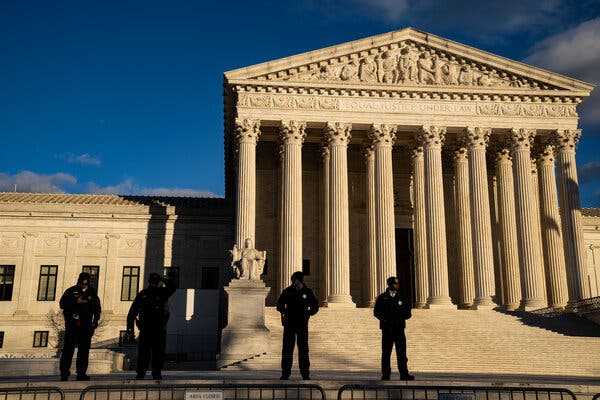By a 5-to-4 vote, the justices sided with John Montenegro Cruz, who was sentenced to death by jurors who were not told he would be ineligible for parole if they voted for a life sentence.
-
Send any friend a story
As a subscriber, you have “>10 gift articles to give each month. Anyone can read what you share.
Give this articleGive this articleGive this article

The Supreme Court’s ruling on Wednesday will allow the death row inmate at the center of the case to press his argument in state court that he is entitled to a new sentencing hearing.
WASHINGTON — The Supreme Court on Wednesday ruled in favor of an inmate in Arizona who was sentenced to death by a jury that was not told that a life sentence would ensure that he remained in prison for the rest of his days.
The vote was 5 to 4, with Chief Justice John G. Roberts Jr. and Justice Brett M. Kavanaugh joining the court’s three liberal members — Justices Sonia Sotomayor, Elena Kagan and Ketanji Brown Jackson — to form a majority.
The ruling will allow the inmate, John Montenegro Cruz, to press his argument in state court that he is entitled to a new sentencing hearing at which jurors would be informed that any life sentence they imposed would not include the possibility of parole.
Mr. Cruz was convicted of the 2003 murder of Patrick Hardesty, a Tucson police officer. At his trial in 2005, his lawyers tried to inform the jury that he would not be eligible for parole were he to receive a life sentence. A 1994 Supreme Court decision, Simmons v. South Carolina, had ruled that capital defendants have a constitutional right to do so.
The trial judge refused to tell the fact to the jury, ruling that the 1994 decision did not apply to Arizona’s sentencing scheme. The jury recommended a death sentence.
Understand the U.S. Supreme Court’s Term
Card 1 of 6
A race to the right. After a series of judicial bombshells in June that included eliminating the right to abortion, a Supreme Court dominated by conservatives returned to the bench in October — and there are few signs that the court’s rightward shift is slowing. Here’s a closer look at the term:
Affirmative action. The marquee cases of the term are challenges to the race-conscious admissions programs at Harvard and the University of North Carolina. While the court has repeatedly upheld affirmative-action programs, a six-justice conservative supermajority may put more than 40 years of precedent at risk.
Voting rights. The role race may play in government decision-making also figures in a case that is a challenge under the Voting Rights Act to an Alabama electoral map that a lower court had said diluted the power of Black voters. The case is a major new test of the Voting Rights Act in a court that has gradually limited the law’s reach in other contexts.
Discrimination against gay couples. The justices heard an appeal from a web designer who objects to providing services for same-sex marriages in a case that pits claims of religious freedom against laws banning discrimination based on sexual orientation. The court last considered the issue in 2018 in a similar dispute, but failed to yield a definitive ruling.
Company protection from social media comments. The court heard a case challenging a law that protects tech companies from lawsuits over what their users post online. The case could have potentially seismic ramifications for the social media platforms that have become conduits of communication, commerce and culture for billions of people.
What constitutes online threats. The court will soon have a chance to determine when creepy Facebook messages cross a constitutional line. The justices will hear arguments in April on a case involving a man who sent repeated disturbing messages to a singer-songwriter. The court has not been especially clear about what constitutes a threat under the First Amendment.
The next day, three jurors issued a statement saying that they had made a “gut-wrenching decision” and that “there was not one person on the jury who did not cry.” They said that they would have voted for life had they known there was no possibility of parole. A fourth juror later made a similar statement.
Mr. Cruz asked for a new trial, arguing that the jury had been misinformed. The judge ruled against him, as did Arizona’s Supreme Court. In 2016, after Mr. Cruz’s appeals were concluded, the Supreme Court ruled in Lynch v. Arizona that the Simmons decision did apply to Arizona’s sentencing scheme.
But when Mr. Cruz tried to raise the issue again, state courts rejected his challenge under a state law that limits post-conviction proceedings unless the inmate can show that there had been a significant change in the law.
Justice Sonia Sotomayor, writing for the majority, said Mr. Cruz’s case was a rare one in which the Supreme Court should second-guess a state court’s interpretation of a state law.
“Lynch overruled binding Arizona precedent,” she wrote. “Before Lynch, Arizona courts held that capital defendants were not entitled to inform the jury of their parole ineligibility. After Lynch, Arizona courts recognize that capital defendants have a due process right to provide the jury with that information when future dangerousness is at issue. It is hard to imagine a clearer break from the past.”
More on the U.S. Supreme Court
- Ethics Code: As calls for the Supreme Court to adopt an ethics code mount, the justices continue to wrestle with whether to adopt a policy similar to one that applies to all other federal judges.
- Road to a Clerkship: A study found that the chances of obtaining a coveted Supreme Court clerkship are considerably higher for people with undergraduate degrees from Harvard, Yale or Princeton.
- Bathroom Bans: After a ruling created a split among federal appeals courts on whether schools can forbid transgender students to use restrooms matching their gender identities, the issue might now be headed to the Supreme Court.
- Leaked Draft Opinion: The court announced that an internal inquiry failed to identify who leaked a draft of the opinion that overturned Roe. The investigation included interviews with all nine justices.
In dissent, Justice Amy Coney Barrett said Mr. Cruz had not cleared the high bar justifying intervention by the Supreme Court in matters ordinarily left to state courts. “The bar is met only by a decision so blatantly disingenuous that it reveals hostility to federal rights or those asserting them,” she wrote. “Given the respect we owe state courts, that is not a conclusion we should be quick to draw — and ordinarily, we are not quick to draw it.”
She added: “The court makes a case for why the Arizona Supreme Court’s interpretation of its own precedent is wrong. If I were on the Arizona Supreme Court, I might agree. But that call is not within our bailiwick.”
Justices Clarence Thomas, Samuel A. Alito Jr. and Neil M. Gorsuch joined Justice Barrett’s dissent in the case, Cruz v. Arizona, No. 21-846.
Source: nytimes.com



